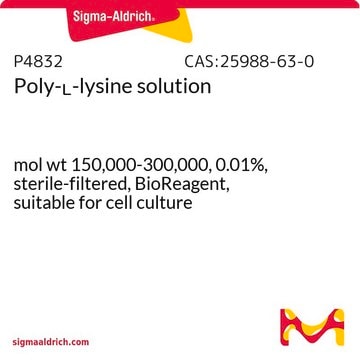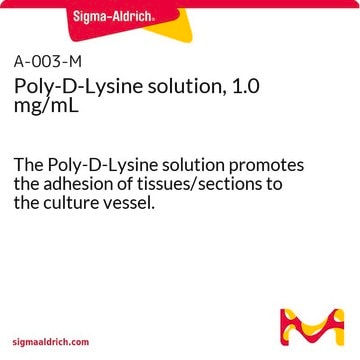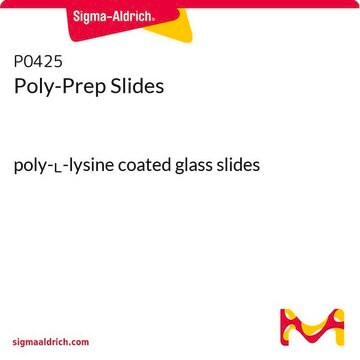Yes, the product P4707 is suitable for coating glassware for cell culture. The difference between Poly L and Poly D lysine lies in their stereoisomeric properties. Poly-L-Lysine is a charge enhancer and can be used for coating many surfaces, including tissue culture plasticware and glassware. However, certain cells can digest poly-L-lysine, in which case the poly-D-lysine, such as P7405, should be used. This product can also be used to coat tissue culture plasticware and glassware.
P4707
Poly-ʟ-Lysine Hydrobromide
synthetic, liquid, 0.01%, suitable for cell culture
Sinônimo(s):
Solução PLL
About This Item
Produtos recomendados
Nome do produto
Poli-L-lisina, 0.01%, sterile-filtered, BioReagent, suitable for cell culture
esterilidade
sterile-filtered
Nível de qualidade
linha de produto
BioReagent
Formulário
liquid
peso molecular
70—150 kDa
embalagem
pkg of 50 mL
concentração
0.01%
técnica(s)
cell culture | mammalian: suitable
cobertura de superfície
4 μg/cm2
Impurezas
endotoxin, tested
solubilidade
water: soluble
Condições de expedição
ambient
temperatura de armazenamento
2-8°C
cadeia de caracteres SMILES
N([C@@H](CCCCN)C(=O)N[C@@H](CCCCN)C(=O)O)C(=O)[C@@H](N)CCCCN
InChI
1S/C18H38N6O4/c19-10-4-1-7-13(22)16(25)23-14(8-2-5-11-20)17(26)24-15(18(27)28)9-3-6-12-21/h13-15H,1-12,19-22H2,(H,23,25)(H,24,26)(H,27,28)/t13-,14-,15-/m0/s1
chave InChI
WBSCNDJQPKSPII-KKUMJFAQSA-N
Procurando produtos similares? Visita Guia de comparação de produtos
Descrição geral
Aplicação
- As lamínulas de vidro revestidas de poli-L-lisina foram usadas para montar amostras para microscopia eletrônica de varredura.[1]
- Os poços revestidos de poli-L-lisina foram usados para prender células PC-12 em eletrodos.[2]
- As lâminas de vidro borossilicato revestidas de poli-L-lisina foram usadas para semeadura de células transduzidas com vetor viral.[3]
Ações bioquímicas/fisiológicas
Componentes
Nota de preparo
produto comparável
produto relacionado
Código de classe de armazenamento
12 - Non Combustible Liquids
Classe de risco de água (WGK)
WGK 2
Ponto de fulgor (°F)
Not applicable
Ponto de fulgor (°C)
Not applicable
Escolha uma das versões mais recentes:
Já possui este produto?
Encontre a documentação dos produtos que você adquiriu recentemente na biblioteca de documentos.
Os clientes também visualizaram
Artigos
Poly-Lysine enhances cell binding with positively-charged surface ions, optimizing electrostatic interaction on culture surfaces for increased cell attachment.
3D cell culture overview. Learn about 2D vs 3D cell culture, advantages of 3D cell culture, and techniques available to develop 3D cell models
Cancer stem cell media, spheroid plates and cancer stem cell markers to culture and characterize CSC populations.
Protocolos
Adhere cells to solid substrates using poly-lysine, which enhances electrostatic interaction between negatively charged ions of the cell membrane and the culture surface.
-
Is the product P4707 suitable for coating glassware for cell culture? Also, what is the difference between Poly L and Poly D lysine?
1 answer-
Helpful?
-
-
When coating coverslips with item P4707, is it necessary to wash the reagent off after 5 minutes, or is there a different recommended procedure?
1 answer-
The product is provided as a 0.01% sterile filtered solution in water. When coating slides with this solution, it is recommended to incubate for 5 minutes and allow the slides to dry at room temperature.
Helpful?
-
-
How many times can it be reused?
1 answer-
The number of times that this product may be re-applied has not been determined. This would be dependent on several factors, such as surface area, material type, surface pretreatment, and incubation period. Please see the link below to review the product datasheet for additional information:
https://www.sigmaaldrich.com/deepweb/assets/sigmaaldrich/product/documents/244/731/p4707pis.pdfHelpful?
-
-
What is the molecular weight of product P4707?
1 answer-
Poly-L-lysine solution is 70-150 kDa molecular weight.
Helpful?
-
-
What is the protocol for using Product P4707, Poly-L-Lysine solution, to coat tissue culture plasticware?
1 answer-
A solution of 0.1 mg/mL is prepared; 0.5 mL of that solution is aseptically transferred to a non-tissue culture treated 25 square cm flask. The flask is gently rocked to evenly coat the surface. After five minutes, the excess solution is removed and the surface is thoroughly rinsed with sterile water and allowed to dry for several hours.
Helpful?
-
-
How can I sterilize slides coated with Product P4707, Poly-L-Lysine solution?
1 answer-
Poly-L-Lysine coated slides can be exposed to UV light overnight for sterilization.
Helpful?
-
-
Should I use Poly-L-Lysine or Poly-D-Lysine?
1 answer-
Certain cells secrete proteases, which can digest poly-L-lysine. For those cell types, poly-D-lysine should be used.
Helpful?
-
-
What is the protocol for using Product P4707, Poly-L-Lysine solution, to coat slides?
1 answer-
For coating slides with poly-L-lysine, in general, it is recommended to use a 0.01% (w/v) solution. After a 5 minute incubation, the excess solution is removed and the slides are dried at room temperature or in an oven at gentle heat.
Helpful?
-
-
What is the Department of Transportation shipping information for this product?
1 answer-
Transportation information can be found in Section 14 of the product's (M)SDS.To access the shipping information for this material, use the link on the product detail page for the product.
Helpful?
-
-
What is the concentration of Product P4707, Poly-L-Lysine solution?
1 answer-
This product is supplied as a 0.01% w/v solution.
Helpful?
-
Active Filters
Nossa equipe de cientistas tem experiência em todas as áreas de pesquisa, incluindo Life Sciences, ciência de materiais, síntese química, cromatografia, química analítica e muitas outras.
Entre em contato com a assistência técnica








